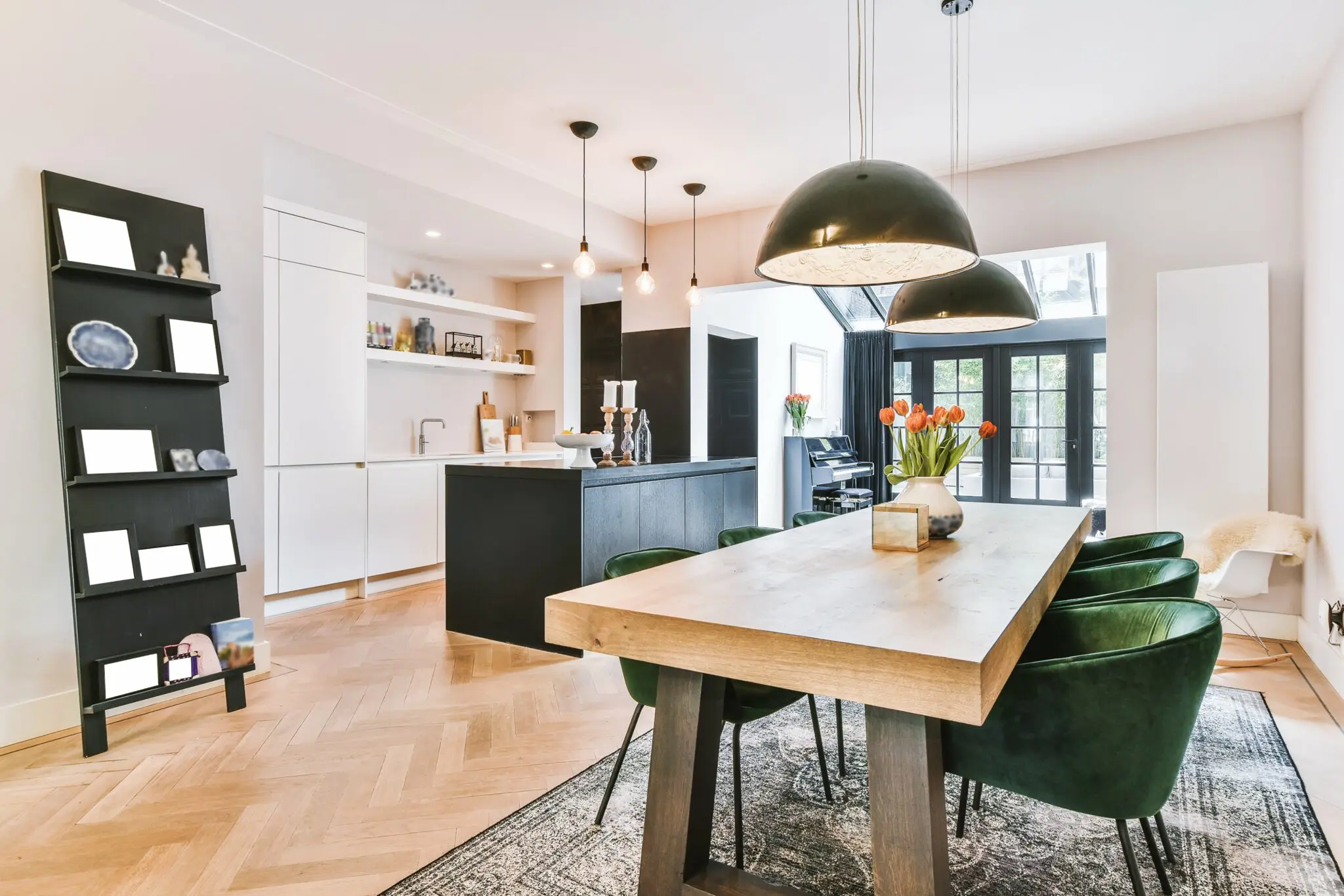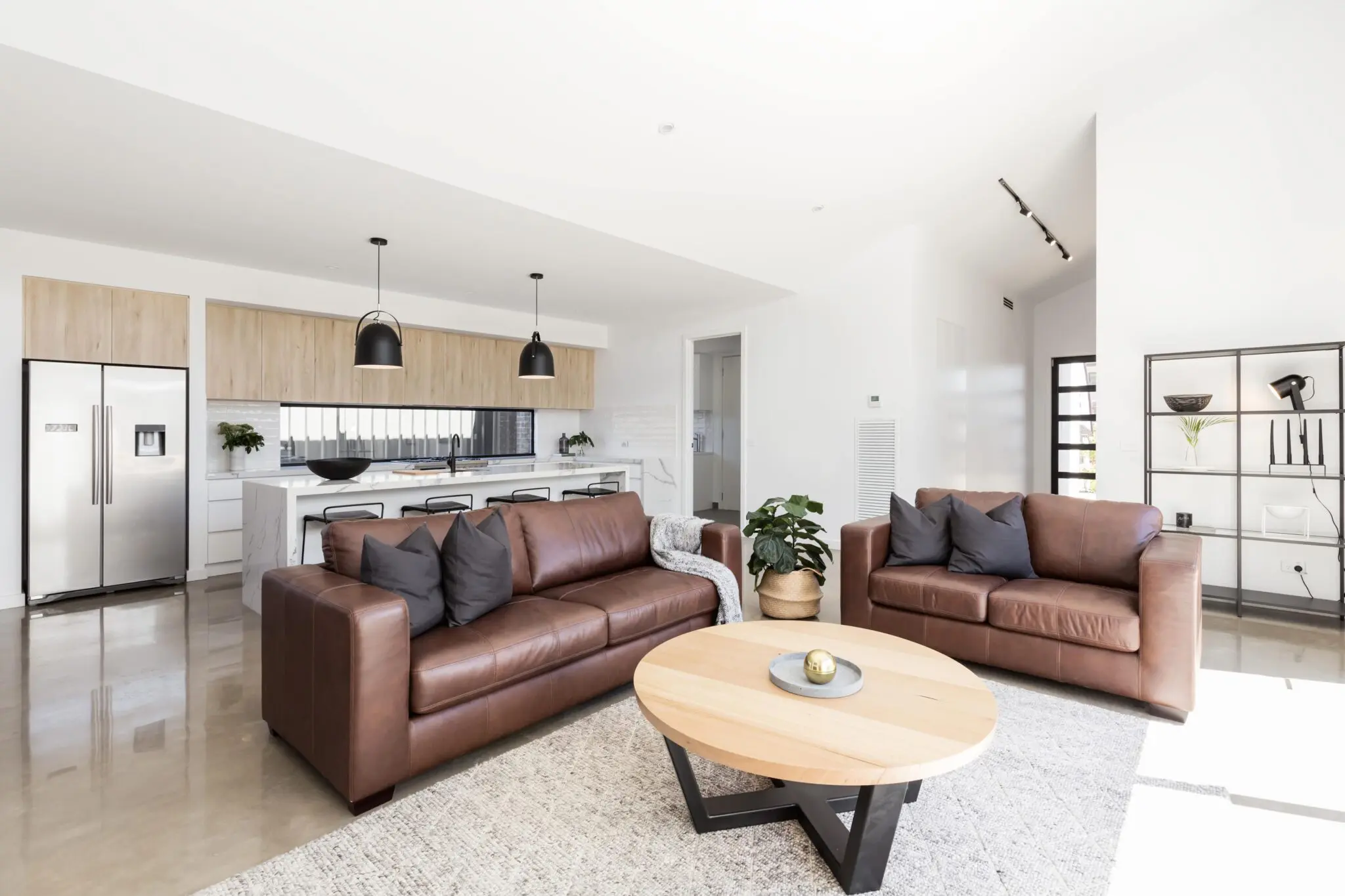WHAT IS AN OPEN FLOOR PLAN?
An open floor plan is a joint room that combines a home’s kitchen, dining room, and living room with no walls to separate them.
If you’re considering a home remodel you’ve likely stumbled across the phrases “open floor plan”, “open concept design”, or the newly formed “great room floor plans”. This style of interior design architecture has been the dominant trend for years and has been the goal of many major remodeling projects. As stated above, the objective is to join the kitchen and dining room, dining room and living room, or all three into some form of communal living space. Join NYKB, leaders in New York home renovations, as we lay out the pros and cons of open floor plans.
IN MORE DETAIL: WHAT IS AN OPEN FLOOR PLAN
So, what is a great room in a house? And what exactly constitutes an open floor plan? An open floor plan is the generic term used in residential architecture, that makes use of large, open spaces and minimizes the use of small, enclosed rooms. Generally, these rooms have two or more common spaces joined together to form a larger space by eliminating partition walls. Discover how our entire apartment renovation on West 11th Street transformed the kitchen with an open floor plan, creating a seamless and spacious design perfect for modern living.
That being said, this doesn’t mean that every room needs to be connected to constitute an open design. Open concept floor plans apply only to common areas, most often some combination of kitchen, dining room, and living room. The openness of the space is meant to:
- Expand the living room in your home
- Foster communication and bonding of those who live in the space
- Create a sense of togetherness and interaction while entertaining.
Although a kitchen and dining area are often seen as connected spaces, they can be “separated” by an island or peninsula!


OPEN FLOOR PLAN HOMES: A BRIEF HISTORY
Open concept kitchen living room floor plans have dominated the market for over 3 decades, becoming the primary architectural trend of new constructions starting in the 1990s. They first started gaining popularity around the 1950s, when entertainment became less formal overall. Pre-World War II entertaining was a relatively formal affair in which the kitchen was distinctly separate from the entertaining/dining space and always off-limits to guests of the house. It wasn’t until after the war that the open floor plan that we know today really started to take shape.
Formality gave way to a more casual attitude and began to incorporate the kitchen, offering more design flexibility for reconfiguring the space as the family changed and grew. Due to the baby boom, more homes were being created in the same amount of space, meaning that floor space became a premium. No longer were luxuries like libraries, sitting rooms, and studies deemed important in home architecture. Growing families were instead looking for a way to keep an eye on multiple children at once, while still performing tasks like cooking or cleaning. Thus the open floor plan became the go-to style of the decade.
While this design style was viewed as “modern” and “cutting-edge” in the 1950s, by the 1990s this was the norm in home design, particularly in suburbia. This trend holds true today, where being able to use the terms “open floor plan,” open concept,” or “great room” adds real estate value to a home. Recently, we have seen more families starting to explore the more traditional, closed-room architecture model, particularly with more and more people currently working from home. It allows for greater privacy and can help homes feel less cluttered. Still, for the vast majority of homeowners, an open floor plan is highly prized when shopping for a new house, and creating an open floor plan is often the reason why people undertake major remodeling projects. Open floor plans allow for individual activities and social togetherness to coexist: family members can do their own activities, yet still communicate with one another. When it comes to entertaining, the kitchen, dining room, and living room blend together into one large party space.


OPEN FLOOR PLAN VS CLOSED
While open concept floor plans are perfect for some, they don’t work for all. Here we’ve laid out the pros and cons of an open floor plan.
BENEFITS OF AN OPEN FLOOR PLAN
- Improved Traffic Flow
Without doors to open and close and no walls to hinder traffic, people can move through the space unhindered. Open concepts are especially valuable for larger households with busy schedules, because there’s enough room for everyone to move around as they go about their day.
- Flexibility
The beauty of the open floor plan is that it makes the space very flexible. The space can serve as a family room, a recreation room, a home office, or an entertainment space depending on your needs at the moment. Without walls to dictate room functions, it’s easy to move around furniture and accessories to find what works best for you at any given time!
- Makes a Small Space Feel Larger
You see open floor plans a lot in urban areas, mainly because urban apartments and homes tend to have a smaller footprint than other areas. Open-concept homes allow small spaces to feel much larger than they actually are. Small kitchen and living room spaces can feel so much smaller when they’re cut up by walls that delineate one living space from another. A not-so-tricky way to trick the eye into thinking that you’ve got more square footage than you really do is by tearing down walls and opening up your rooms to each other.
- Easy Entertaining
Of course, open floor plans were made for entertaining, and the flow of one room into the next makes entertaining very easy and accessible. This layout is great for hosting parties because there is plenty of room for your guests to socialize and mingle. Without barriers such as doors and walls, you can have a seamless conversation with your guests while you prepare snacks on the kitchen island.
- More Light
Finally, an open layout without barriers and walls will help bring a lot more light to your space. Natural light will be able to flow easily from one room’s window into another room. Spaces that were once without windows now receive natural light from windows in exterior walls, and that light will bounce off walls, mirrors, and other surfaces to create an overall brighter room!
DISADVANTAGES OF AN OPEN FLOOR PLAN
- Spaces Can Feel Cluttered
One of the biggest drawbacks for some people considering an open floor plan is that there is no place to hide a mess. ‘Out of sight, out of mind’ isn’t really an option because even the smallest amount of clutter can make the space appear messy. So if you’re the kind of person who can’t relax until everything’s in order, open-plan living may be tricky for you.
- Could Cost More to Heat and Cool
A large open space will ultimately cost more to heat and cool than closed-off rooms because you are attempting to heat or cool a much larger area than a traditional room. Great rooms with high ceilings are often energy draining, especially when the outer walls are equipped with large windows (as they often are).
- Lack of Privacy
While rooms that require privacy like the bathroom and the bedroom are sequestered, having an open floor plan throughout the rest of your home drastically reduces the amount of private places available. If you like your privacy and enjoy being on your own, an open plan could be quite overwhelming.
- Noisy
It stands to reason that a home without walls will create more noise. While an open floor plan does have its advantages like increasing ability to communicate, a lack of interior walls means the sound will travel between rooms all the time, which can result in fewer areas of quiet or privacy.
- Amplified Design Choices
This can actually be viewed as a pro OR a con. If you are remodeling your house you’re going to want to show off your design choices as much as possible. However, with an open floor plan there is nowhere to hide, and having something that stands out against the rest of the space can disrupt the flow and feel of your entire great room. When you’re thinking about remodeling an already open space or knocking down walls to create an open space, we highly recommend working with a design professional to ensure that your whole space is consistent and turns out how you envisioned it!
FAQ’S
Below you’ll find a couple of frequently asked questions:
ARE OPEN FLOOR PLANS GOING OUT OF STYLE?
Open floor plans have been popular for years, however, with people spending more and more time at home, real estate experts say many are now looking for a more divided space.
HOW TO PAINT AN OPEN FLOOR PLAN?
Stick to neutral color groups when painting an open floor plan. While choosing two or three tones can look beautifully complementary, too many colors can create chaos in your great room.
OPEN FLOOR PLANS EXPLAINED, TO CHOOSE OR NOT TO CHOOSE?
Now that you’re no longer in the dark as to what an open floor plan is, we hope this has given you some insight as to whether it will work for you. There is a lot to consider when thinking about completely changing the layout of your home; do you value privacy and alone time? Are there load-bearing walls that could cause an issue? Do you need a separate space to work from home? All of these considerations will need to be taken into account when deciding if an open-concept design will work in your home. To discuss your unique requirements with our professional design team today, don’t hesitate to contact our team, or book your free at-home consultation. With over 20 years of experience improving homes in New York, we at NYKB have what it takes to make your home perfect.

